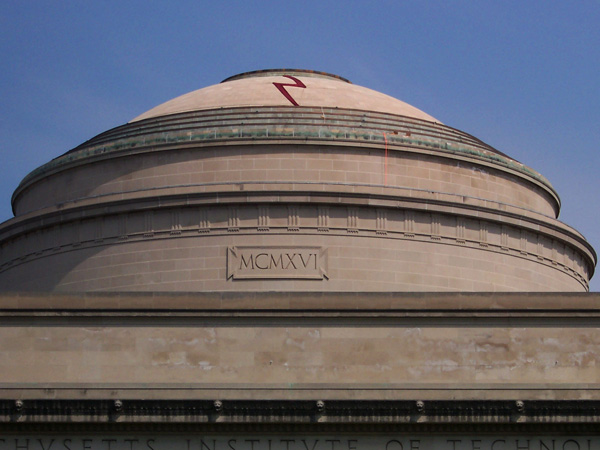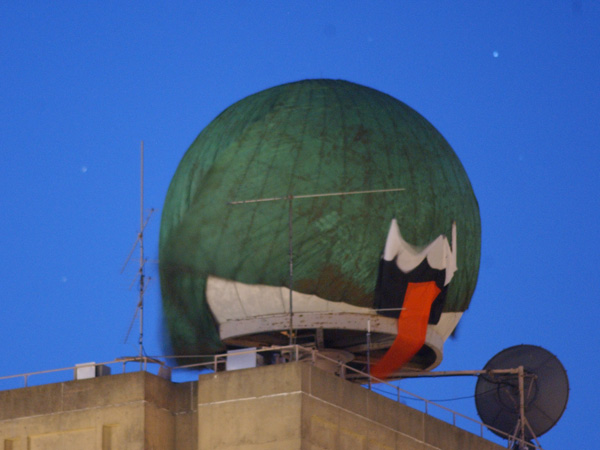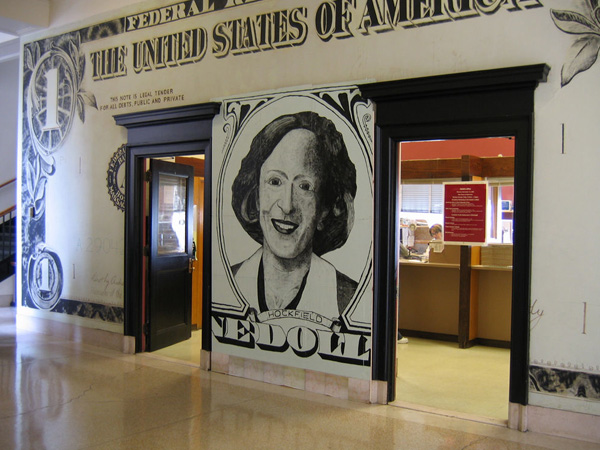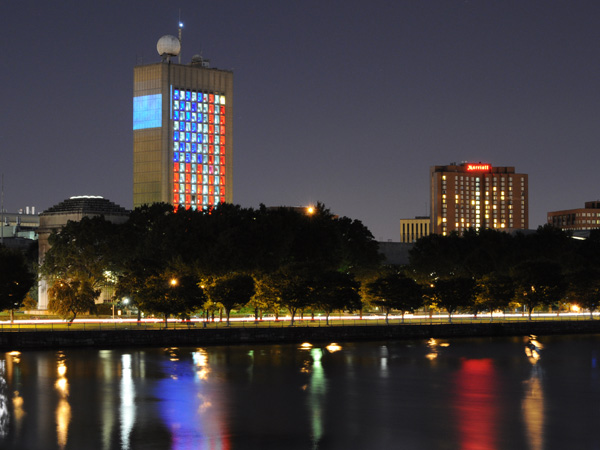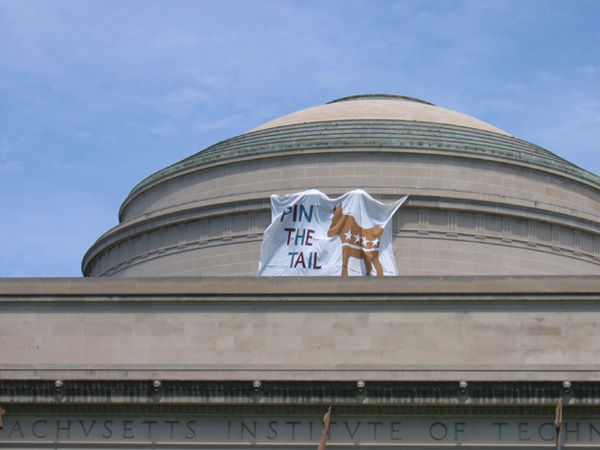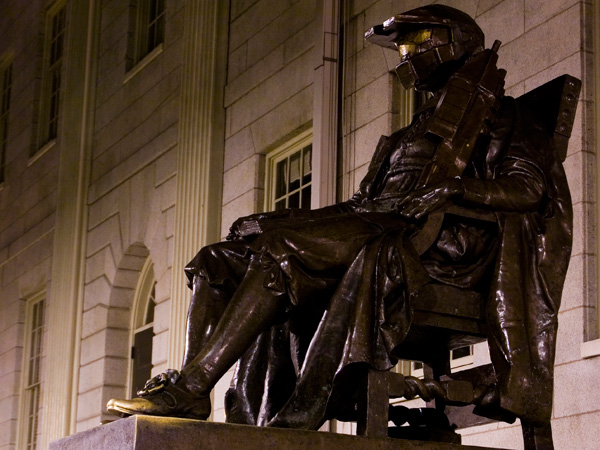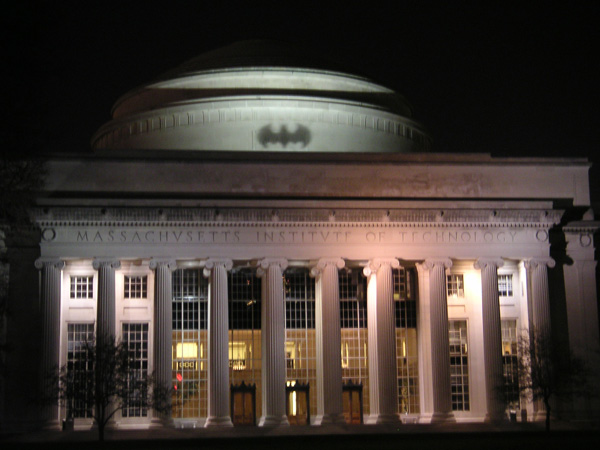A History of MIT Pranks
From homemade torpedoes to purloined police cars.
A police car with its lights flashing balanced on top of the Massachusetts Institute of Technology's Great Dome. A balloon reading “MIT” appearing out of the ground, midfield, during the 1982 Harvard-Yale football game. A perfectly recreated upside-down lounge room, complete with billiard table and snoozing cat, installed on the underside of an arch during MIT’s 2010 Campus Preview Weekend. These “hacks,” as they are known in MIT lore, showcase a combination of meticulous science and anti-authoritarian whimsy, both of which are synonymous with the university. MIT pranks have been memorialized in various sanctioned galleries around campus as an integral part of the university’s history, and rightly so. Although the terminology and ethos of the hacks were only formalized after World War II, pranks at MIT have been around since the university opened in 1865.
While writing my novel The Technologists, a thriller about the first students at MIT, I looked for early recorded pranks to incorporate into my story. The history of hacks published by MIT Press, Nightwork: A History of Hacks and Pranks at MIT, reaches back to an incident in the 1870s in which students sprinkled iodide of nitrogen over the grounds of a military drill, causing explosions under classmates' boots. But as something of a purist about firsts, I sought out earlier examples of the college's signature pranks including, if possible, the inaugural one. Was there a Big Bang of MIT pranks?
As I chased the answer, I realized that the students’ shenanigans provided not just a chronicle of cleverness, but also shed some light on the history of scientific education in America. The military drills were natural draws for mischief during the era of its first classes. Massachusetts granted the institution land in the newly developed Back Bay of Boston for its original building and in return mandated that its students learn military maneuvers. The grant, part of a federal initiative, was a coup for what was at the time a highly experimental college promoting the outré notion of laboratory teaching, but that did not make the required drills welcome to the students. In one prank contemporaneous with the sprinkled nitrogen triiodide, students dropped a “giant torpedo” from the fourth floor to surprise their marching classmates gathering in the main hall. This sounds dangerous, and although the student memoirist spared more details, it must have been impressively well-planned not to cause any harm, presaging one of the unofficial rules of the modern hacks.
An even earlier recorded prank target was MIT’s first professor of mechanical engineering, William Watson. Watson was called “Squirty” by the students for his enthusiastic handling of chemical-wash bottles, and he was teased for the dapper style of dress he had picked up when studying science in Paris. Robert Hallowell Richards, a member of MIT’s first class, remembered this practical joke: “Professor Watson arranged a blackboard that was lowered and raised by means of a rope and a cast-iron weight, operated over a pulley. The first time he pulled the board down, the weight bobbed up over the top. This was too much for the conspirators. They stole into the room between classes and expended much artistic labor on the surface of the weight. The next time Watson pulled the blackboard down, up shot the weight, pleasantly decorated for the occasion with a picture of a monkey and the inscription, ‘Squirty Watson.’ ”
Both the torpedo and the blackboard pranks required some skill in engineering, but after reviewing student diaries, letters, faculty records, and alumni notes, the earliest cluster of pranks I can identify—between the years 1865 to 1868, when the first cohort of young men matriculated and graduated—form a surprisingly tame list. It seems impossible to isolate a single incident as the first, but the ones I traced back the farthest include moving a safe to block a stairway; bringing a monkey and hand organ into a hall (another ploy to annoy “Squirty” Watson); a bell being positioned to ring over the head of the professor of foreign languages; and the theft of a key, one possibly needed by the faculty or staff to open one of the laboratories or the large lecture hall, which was thrown down a well.
None of these would have made it into the MIT “Hall of Hacks” hosted by the university's museum until 2001. With the possible exception of the bell, which I imagine as rigged to toll when the professor made a certain movement or perhaps leaned on his podium, these ruses don't appear to have required much scientific or engineering know-how. We would be safe to surmise that the freshmen of the class of 1868—who arrived when there were no other students but the freshmen—did not yet have the training that would have allowed them to, say, mix the nitrogen composite of the 1870s.
But there is something else to note in the banality of the original hacks other than just their lack of scientific aplomb. In its early days, the public considered MIT not only strange, but doomed to failure. People saw the Institute, in the words of one of the first MIT professors, as “the refuge of shirks and stragglers from the better organized and stricter colleges,” and, as another early polytechnic professor wrote bluntly, “a resort for college weaklings.” Even the focal word in the Institute's title, “technology,” could be off-putting in its unfamiliarity, dating back only to 1829 when used to indicate the application of sciences and mechanical arts to improve industry and manufacturing. It was not uncommon in the school’s early years for a father to abruptly pull his son out of the Institute once he realized how radically MIT diverged from established universities—not just in advancing a “practical” curriculum based on scientific experiments, but completely omitting ancient languages and requiring no religious worship. Rather than attempts to show off scientific acumen, the earliest MIT pranks were the acts of students trying to remind themselves that they were not so different from their peers at “better” colleges and universities, where silly pranks were rampant. Across the Charles River, not far from the future home of MIT, Harvard students threw boots out of windows at policemen and set off fireworks in professors' offices.
But if some of the students wanted to emulate their Ivy League counterparts, the faculty could not afford to do the same, a fact on which the evolution of pranks at MIT hinged. Catching and purging pranksters was a priority at more established institutions. In 1805, Yale authorities expelled James Fenimore Cooper after a retaliatory prank involving gunpowder, and Harvard repeatedly tried to shut down the so-called “Med Fac,” a secret society devoted to mischief-making around campus. By contrast, the first groups of MIT “conspirators” had considerable leeway, if not impunity. “The surroundings were very unsuited to aid in what might be called the policing of the school,” explained one of the original students. He also noted that the authorities “never made the mistake of regarding a prank as a crime.” The student's point about policing is certainly true: MIT occupied a series of rented spaces before moving into a building on Boylston Street 10 times too large for the student body, making it extremely difficult to monitor students when they were not sitting in a laboratory or classroom. But it was more than a matter of failing to catch the culprits red-handed or being philosophical about tomfoolery. The Institute simply couldn't survive a disciplinary policy resulting in suspensions and the loss of much-needed tuition—at times there were not enough funds to pay its faculty.
In retrospect, MIT's penury may have been a blessing for its identity. The early generations of students used their unusual freedom to hone an entirely different style of pranks than their counterparts at other colleges, and this style became a tradition that grew with their exceptional scientific abilities. Rather than being pushed underground like Harvard's now defunct Med Fac, brainy pranks became a welcome part of MIT's culture. These days, they're lauded not only in the university's museum but by its admissions office. That might constitute the greatest stunt ever pulled off in the academy.
